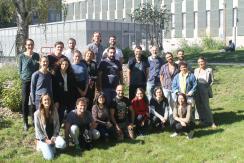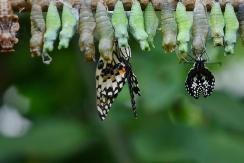COEVOL Multi-Scale Coevolution
Living systems are highly integrated, with a multitude of levels of organization, from molecular and intra-cellular scales to ecosystems. Complex organisms are themselves consortia of macro- and micro-organisms, which work together with their host to build the individual. Yet, each of these organisms can function and evolve in the short term according to its own logic, possibly in conflict with other higher or lower levels, or with other time scales. The once common idea among evolutionists that natural selection results in organisms perfectly adapted to their environment is now severely undermined. Not only because, as the Red Queen explains to Alice, one has to run relentlessly to keep its place in a changing environment, or because past evolutionary history and chance constrain the possibilities of present adaptation, but also because different levels of selection have interests that are generally difficult to reconcile.
Multi-scale coevolution resets classical questions in evolutionary biology
One example, of particular interest is the question of the source of heritable variations. The phenotype of organisms in a population is influenced not only by variations in their nuclear and mitochondrial genomes, the dynamics of which is the object of population genetics, but also more and more patently by the consortium of microbes and genetic elements that constitute its microbiome and virome. The hologenome designates this complex assembly of genetic materials, which obey different rules of transmission and different evolutionary strategies. The ability of symbionts to manipulate host phenotypes or to interfere with each other influences the evolutionary dynamics of all players in ways that are yet poorly understood. In addition, new questions arise, such as the importance of co-adaptation in these systems and their consequences in maintaining cohesive biological systems.
- Symbiosis: a response to and a source of divergent selection
Using a variety of approaches combining experimental evolution, genomic, functional, phenotypic and behavioral data, we aim to test whether symbiosis facilitates diversification and to characterize the underlying microevolutionary processes.
- Ecological networks of horizontal gene transfer
We develop original methods to detect gene transfer and we investigate the factors that influence the routes of gene transfers among microbes but also among insects.
- The interplay between symbiosis, infection and immunity and its evolutionary consequences
We try to understand the intimate interaction of hosts with pathogens, symbionts and transposable elements and how it affects the extended phenotype of the host.
- Transgenerational inheritance and environment changes
We try to decipher the molecular mechanisms that underlie rapid adaptation to environment and to test for transgenerational inheritance of fitness traits.
- Intragenomic conflicts and demography
We are developing models to test whether changes in the demography of the host affect the dynamics of transposable elements.
- The determinism of phenotypic convergence
We study the genomic basis of convergent phenotypic evolution in particular in the case of animals and plants adaptation to increasing temperature and decreasing water.
- Reconciling the tree of life
We develop phylogenetic methods for “reconciling” gene/species or host/symbiont histories and use these methods to explore the bulk of extinct or undescribed species and the history of association of symbiotic microbes with their hosts.
Integrating methods
The methods we use to tackle the questions raised by multi-scale co-evolution extend from theory, modelling and simulation to big data analysis, lab (notably on insects), and to a lesser extent, field activities.
Implication of research, responsibility of researchers and citizen sciences
From our research (some of which have immediate consequences in health, agriculture and ecology) and our concerns about the responsibility of scientists in society, we are committed to promote an “implicative” research. The implicative position means that we try to work on the link between science and society, not only through a one-way communication, applying or explaining our science, but also favoring early discussions on research projects, that may influence our research directions.
Publications
Display of 301 to 330 publications on 709 in total
A role for HOX13 proteins in the regulatory switch between TADs at the HoxD locus
Genes and Development . 30 : 1172-86
Journal article
see the publicationRevBayes: Bayesian Phylogenetic Inference Using Graphical Models and an Interactive Model-Specification Language
Systematic Biology . 65 : 726-36
Journal article
see the publicationIs genome size of Lepidoptera linked to host plant range?
Entomologia Experimentalis et Applicata . 159 ( 3 ) : 354-361
DOI: 10.1111/eea.12446
Journal article
see the publicationThe sublethal effects of endosulfan on the circadian rhythms and locomotor activity of two sympatric parasitoid species
Chemosphere . 132 : 200-5
Journal article
see the publicationCompetitive outcome of multiple infections in a behavior-manipulating virus/wasp interaction
Ecology and Evolution . 5 ( 24 ) : S934-S945
DOI: 10.1002/ece3.1749
Journal article
see the publicationGenome reduction and potential metabolic complementation of the dual endosymbionts in the whitefly Bemisia tabaci
BMC Genomics . 16 : 226
Journal article
see the publicationThe Recent Evolution of a Maternally-Inherited Endosymbiont of Ticks Led to the Emergence of the Q Fever Pathogen, Coxiella burnetii
PLoS Pathogens . 11 ( 5 )
Journal article
see the publicationTwo Host Clades, Two Bacterial Arsenals: Evolution through Gene Losses in Facultative Endosymbionts.
Genome Biology and Evolution . 7 ( 3 ) : 839-855
DOI: 10.1093/gbe/evv030
Journal article
see the publicationResponse to Comment on "Statistical binning enables an accurate coalescent-based estimation of the avian tree
Science . 350 ( 6257 ) : 171-171
Journal article
see the publicationThe inference of gene trees with species trees
Systematic Biology . 64 ( 1 ) : e42-e62
Journal article
see the publicationReconstruction of an ancestral Yersinia pestis genome and comparison with an ancient sequence
BMC Genomics . 16 ( Suppl 10 ) : S9
Journal article
see the publicationMoments of genome evolution by Double Cut-and-Join
BMC Bioinformatics . 16 ( Suppl 14 ) : S7
Journal article
see the publicationDetection of genetically isolated entities within the Mediterranean species of Bemisia tabaci: new insights into the systematics of this worldwide pest
Pest Management Science . 71 ( 3 ) : 452-458
DOI: 10.1002/ps.3834
Journal article
see the publicationParasite-Parasite Interactions in the Wild: How To Detect Them?
Trends in Parasitology .
Journal article
see the publicationSpodoptera frugiperda (Lepidoptera: Noctuidae) host-plant variants: two host strains or two distinct species?
Genetica . 143 ( 3 ) : 305-316
Journal article
see the publicationDe novo assembly and annotation of the Asian tiger mosquito (Aedes albopictus) repeatome with dnaPipeTE from raw genomic reads and comparative analysis with the yellow fever mosquito (Aedes aegypti).
Genome Biology and Evolution . 7 ( 4 ) : 1192-205
Journal article
see the publicationDe novo assembly and annotation of the Asian tiger mosquito (Aedes albopictus) repeatome with dnaPipeTE from raw genomic reads and comparative analysis with the yellow fever mosquito (Aedes aegypti)
Genome Biology and Evolution . 7 ( 4 ) : 1192-1205
DOI: 10.1093/gbe/evv050
Journal article
see the publicationSex and evolution
Handbook of Evolutionary Thinking in the Sciences . 978-94-017-9013-0 : 499--507
Book chapter
see the publicationDegeneration of the Nonrecombining Regions in the Mating-Type Chromosomes of the Anther-Smut Fungi
Molecular Biology and Evolution . 32 ( 4 ) : 928-943
Journal article
see the publicationGC-Content evolution in bacterial genomes: The biased gene conversion hypothesis expands
PLoS Genetics . 11 ( 2 ) : 1-20
Journal article
see the publicationKaryotype and Gene Order Evolution from ReconstructedExtinct Ancestors Highlight Contrasts in Genome Plasticity ofModern Rosid Crops
Genome Biology and Evolution . 7 ( 3 ) : 735-749
DOI: 10.1093/gbe/evv014
Journal article
see the publicationFoundations of Coding: Compression, Encryption, Error-Correction
978-1-118-88144-6 : 376
Book
see the publicationThe chemistry of negotiation: Rhythmic, glycan-driven acidification in a symbiotic conversation
Proceedings of the National Academy of Sciences of the United States of America . 112 ( 2 ) : 566 - 571
Journal article
see the publicationWeighted Statistical Binning: Enabling Statistically Consistent Genome-Scale Phylogenetic Analyses
PLoS ONE . 10 ( 6 ) : e0129183
Journal article
see the publicationAssessing Approaches for Inferring Species Trees from Multi-Copy Genes
Systematic Biology . 64 ( 2 ) : 325-339
Journal article
see the publicationAssessing Recent Selection and Functionality at Long Noncoding RNA Loci in the Mouse Genome
Genome Biology and Evolution . 7 : 2432-44
DOI: 10.1093/gbe/evv155
Journal article
see the publicationAncestral gene synteny reconstruction improves extant species scaffolding
BMC Genomics . 16 ( Suppl 10 ) : S11
Journal article
see the publicationProbabilistic modeling of the evolution of gene synteny within reconciled phylogenies
BMC Bioinformatics . 16 ( Suppl 14 ) : S5
Journal article
see the publicationGenome-scale phylogenetic analysis finds extensive gene transfer among fungi
Philosophical Transactions of the Royal Society of London. Series B, Biological Sciences (1934–1990) . 370 : 20140335 (11 pages)
Journal article
see the publicationNuclear and cytoplasmic differentiation among Mediterranean populations of Bemisia tabaci : testing the biological relevance of cytotypes
Pest Management Science . 70 ( 10 ) : 1503-1513
DOI: 10.1002/ps.3792
Journal article
see the publication

